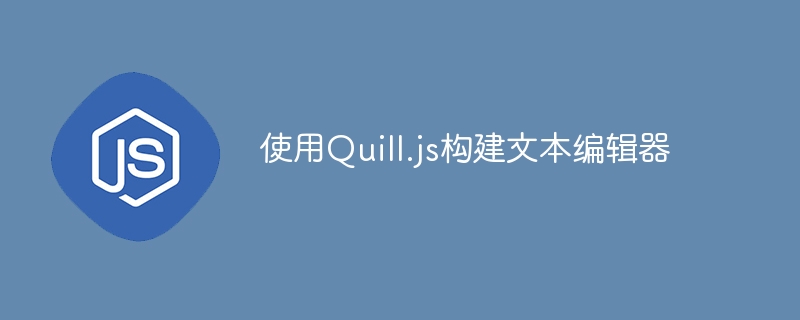使用Quill.js构建文本编辑器

Quill是一款免费且开源的文本编辑器,属于所见即所得编辑器的范畴,主要用于我们今天使用的现代网络。它是一个高度可定制的文本编辑器,具有许多表达性的API。Quill非常易于使用,并提供了一个良好的界面,即使对于只有标记经验的人来说,也很容易理解。
在本教程中,我们将使用多个示例来解释如何使用Quill.js构建文本编辑器。
虽然有许多所属于所见即所得文本编辑器的富文本编辑器,但最广泛使用的是Quill,差距非常大。现在,让我们来学习如何使用Quill。
让我们使用Quill创建一个基本的文本编辑器
与Quill一起工作的第一步是能够在我们选择的编辑器中使用它,并为此,我们需要将下面显示的两个CDN链接放在我们的HTML代码的
标签中。<link href="https://cdn.quilljs.com/1.3.7/quill.snow.css" rel="stylesheet"> <script src="https://cdn.quilljs.com/1.3.7/quill.js"></script>
第一个CDN链接是Quill的CSS样式文件,而第二个CDN链接是Quill的JavaScript文件。我们需要将上面显示的这两行代码添加到我们的HTML代码的
标签中。我们的标签应该看起来像这样。
<head> <meta charset="UTF-8"> <meta http-equiv="X-UA-Compatible" content="IE=edge"> <meta name="viewport" content="width=device-width, initial-scale=1.0"> <title>Quill Text Editor</title> <link href="https://cdn.quilljs.com/1.3.7/quill.snow.css" rel="stylesheet"> <script src="https://cdn.quilljs.com/1.3.7/quill.js"></script> </head>
现在我们已经在
标签中添加了CDN,现在是时候开始处理标签了。在标签内部,让我们创建一个id="editor"的<body> <div id="editor" style="height: 250px"></div> </body>
现在剩下的就是在其中创建一个<script>标签,我们将在其中创建一个Quill类的实例,然后将我们创建的<div>的id作为第一个参数传递,第二个参数基本上是一个对象,我们在文本编辑器中指定对象的属性。</p> <p>考虑下面显示的<b><script>标签</b>。</p> <div class="code" style="position:relative; padding:0px; margin:0px;"><pre class='brush:php;toolbar:false;'><script> var quill = new Quill('#editor', { theme: 'snow' }); </script> </pre><div class="contentsignin">登录后复制</div></div> <p>上述的<script>标签应该放在<body>标签的末尾,即在<body>标签关闭之前。</p> <h3 id="index-html">index.html</h3> <p>整个HTML代码如下所示。</p> <h3 id="Example">Example</h3> <div class="code" style="position:relative; padding:0px; margin:0px;"><pre class='brush:php;toolbar:false;'><!DOCTYPE html> <html lang="en"> <head> <meta charset="UTF-8"> <meta http-equiv="X-UA-Compatible" content="IE=edge"> <meta name="viewport" content="width=device-width, initial-scale=1.0"> <title>Quill Text Editor</title> <link href="https://cdn.quilljs.com/1.3.7/quill.snow.css" rel="stylesheet"> <script src="https://cdn.quilljs.com/1.3.7/quill.js"></script> </head> <body> <div id="editor" style="height: 200px"></div> <script> var quill = new Quill('#editor', { theme: 'snow' }); </script>
如果您在浏览器中打开上述HTML文件,您将在浏览器中看到一个文本编辑器输出。在您将看到的文本编辑器中,我们将有大量的工具栏选项可供我们使用,我们可以在文本编辑器中使用任何一个。
让我们自定义文本编辑器的外观
现在假设我们只想提供两个默认的工具栏选项,而不是在普通文本编辑器中默认获得的所有选项。在这种情况下,我们可以使用下面显示的<script>标签。</p> <div class="code" style="position:relative; padding:0px; margin:0px;"><pre class='brush:php;toolbar:false;'><script> let toolbarOptions = [ ['bold', 'italic', 'underline'] ] let quill = new Quill('#editor', { modules: { toolbar: toolbarOptions }, theme: 'snow' }); </script> </pre><div class="contentsignin">登录后复制</div></div> <p>在上面的<script>标签中,我们只提供了三个选项,即粗体、斜体和下划线,在工具栏中,因此只有这些选项将对文本编辑器可用。</p> <p><b>index.html</b></p> <p>下面显示的是更新后的 index.html 文件。</p> <h3 id="Example">Example</h3> <div class="code" style="position:relative; padding:0px; margin:0px;"><pre class='brush:php;toolbar:false;'><!DOCTYPE html> <html lang="en"> <head> <meta charset="UTF-8"> <meta http-equiv="X-UA-Compatible" content="IE=edge"> <meta name="viewport" content="width=device-width, initial-scale=1.0"> <title>Quill Text Editor</title> <link href="https://cdn.quilljs.com/1.3.7/quill.snow.css" rel="stylesheet"> <script src="https://cdn.quilljs.com/1.3.7/quill.js"></script> </head> <body> <div id="editor" style="height: 200px"></div> <script> var toolbarOptions = [ ['bold', 'italic', 'underline'] ] var quill = new Quill('#editor', { modules: { toolbar: toolbarOptions }, theme: 'snow' }); </script>
如果您在浏览器中运行上述文件,您将只能在文本编辑器中看到三个工具栏选项,即粗体选项、斜体选项和下划线选项。
在控制台中记录文本编辑器的内容
现在假设我们想要将我们在文本编辑器中写的内容记录到控制台中,为了做到这一点,我们首先需要在
标签中创建一个按钮。考虑下面显示的创建按钮的代码片段。
<button onclick="consoleHTMLContent()">Print in Console</button>
现在让我们专注于<script>标签,其中我们需要创建一个函数,该函数将实际记录quill文本编辑器的内容以及一些其他工具栏选项。</p> <p>考虑下面显示的更新的<script>标签。</p> <div class="code" style="position:relative; padding:0px; margin:0px;"><pre class='brush:php;toolbar:false;'><script> let toolbarOptions = [ ['bold', 'italic', 'underline'],[{ 'size': ['small', false, 'large', 'huge'] }],[{ 'color': [] }, { 'background': [] }] ] let quill = new Quill('#editor', { modules: { toolbar: toolbarOptions }, theme: 'snow' }); function consoleHTMLContent() { console.log(quill.root.innerHTML); } </script> </pre><div class="contentsignin">登录后复制</div></div> 在上述<script>标签中,我们有一个名为consoleHTMLContent的函数,其中我打印了quill对象的root属性中存在的内容 <p><b>index.html</b></p> <p>更新后的<b>index.html</b>代码如下所示。</p> <h3 id="Example">Example</h3> <div class="code" style="position:relative; padding:0px; margin:0px;"><pre class='brush:php;toolbar:false;'><!DOCTYPE html> <html lang="en"> <head> <meta charset="UTF-8"> <meta http-equiv="X-UA-Compatible" content="IE=edge"> <meta name="viewport" content="width=device-width, initial-scale=1.0"> <title>Quill Text Editor</title> <link href="https://cdn.quilljs.com/1.3.7/quill.snow.css" rel="stylesheet"> <script src="https://cdn.quilljs.com/1.3.7/quill.js"></script> </head> <body> <div id="editor" style="height: 200px"></div> <button onclick="consoleHTMLContent()">Print in Console</button> <script> let toolbarOptions = [ ['bold', 'italic', 'underline'],[{ 'size': ['small', false, 'large', 'huge'] }],[{ 'color': [] }, { 'background': [] }] ] let quill = new Quill('#editor', { modules: { toolbar: toolbarOptions }, theme: 'snow' }); function consoleHTMLContent() { console.log(quill.root.innerHTML); } </script>
如果我们在浏览器中运行上述代码,我们将会看到一个文本编辑器,一旦我们在编辑器中输入一些文本并点击按钮,quill文本编辑器的根对象将会在控制台中打印出来。
输出
我尝试在编辑器中写了一行简单的代码,然后点击了按钮,这是我在浏览器控制台中得到的输出。
<p>Hi There <strong>Inside HTML </strong><em>Is this italic?</em></p>
结论
在本教程中,我们演示了如何使用Quill.js创建具有不同工具栏选项的文本编辑器。通过多个示例,我们解释了如何添加或删除工具栏,以及如何在Quill文本编辑器中控制根元素。
以上是使用Quill.js构建文本编辑器的详细内容。更多信息请关注PHP中文网其他相关文章!

热AI工具

Undresser.AI Undress
人工智能驱动的应用程序,用于创建逼真的裸体照片

AI Clothes Remover
用于从照片中去除衣服的在线人工智能工具。

Undress AI Tool
免费脱衣服图片

Clothoff.io
AI脱衣机

Video Face Swap
使用我们完全免费的人工智能换脸工具轻松在任何视频中换脸!

热门文章

热工具

记事本++7.3.1
好用且免费的代码编辑器

SublimeText3汉化版
中文版,非常好用

禅工作室 13.0.1
功能强大的PHP集成开发环境

Dreamweaver CS6
视觉化网页开发工具

SublimeText3 Mac版
神级代码编辑软件(SublimeText3)

热门话题
 谁得到更多的Python或JavaScript?
Apr 04, 2025 am 12:09 AM
谁得到更多的Python或JavaScript?
Apr 04, 2025 am 12:09 AM
Python和JavaScript开发者的薪资没有绝对的高低,具体取决于技能和行业需求。1.Python在数据科学和机器学习领域可能薪资更高。2.JavaScript在前端和全栈开发中需求大,薪资也可观。3.影响因素包括经验、地理位置、公司规模和特定技能。
 神秘的JavaScript:它的作用以及为什么重要
Apr 09, 2025 am 12:07 AM
神秘的JavaScript:它的作用以及为什么重要
Apr 09, 2025 am 12:07 AM
JavaScript是现代Web开发的基石,它的主要功能包括事件驱动编程、动态内容生成和异步编程。1)事件驱动编程允许网页根据用户操作动态变化。2)动态内容生成使得页面内容可以根据条件调整。3)异步编程确保用户界面不被阻塞。JavaScript广泛应用于网页交互、单页面应用和服务器端开发,极大地提升了用户体验和跨平台开发的灵活性。
 如何使用JavaScript将具有相同ID的数组元素合并到一个对象中?
Apr 04, 2025 pm 05:09 PM
如何使用JavaScript将具有相同ID的数组元素合并到一个对象中?
Apr 04, 2025 pm 05:09 PM
如何在JavaScript中将具有相同ID的数组元素合并到一个对象中?在处理数据时,我们常常会遇到需要将具有相同ID�...
 如何实现视差滚动和元素动画效果,像资生堂官网那样?
或者:
怎样才能像资生堂官网一样,实现页面滚动伴随的动画效果?
Apr 04, 2025 pm 05:36 PM
如何实现视差滚动和元素动画效果,像资生堂官网那样?
或者:
怎样才能像资生堂官网一样,实现页面滚动伴随的动画效果?
Apr 04, 2025 pm 05:36 PM
实现视差滚动和元素动画效果的探讨本文将探讨如何实现类似资生堂官网(https://www.shiseido.co.jp/sb/wonderland/)中�...
 JavaScript难以学习吗?
Apr 03, 2025 am 12:20 AM
JavaScript难以学习吗?
Apr 03, 2025 am 12:20 AM
学习JavaScript不难,但有挑战。1)理解基础概念如变量、数据类型、函数等。2)掌握异步编程,通过事件循环实现。3)使用DOM操作和Promise处理异步请求。4)避免常见错误,使用调试技巧。5)优化性能,遵循最佳实践。
 console.log输出结果差异:两次调用为何不同?
Apr 04, 2025 pm 05:12 PM
console.log输出结果差异:两次调用为何不同?
Apr 04, 2025 pm 05:12 PM
深入探讨console.log输出差异的根源本文将分析一段代码中console.log函数输出结果的差异,并解释其背后的原因。�...
 前端开发中如何实现类似 VSCode 的面板拖拽调整功能?
Apr 04, 2025 pm 02:06 PM
前端开发中如何实现类似 VSCode 的面板拖拽调整功能?
Apr 04, 2025 pm 02:06 PM
探索前端中类似VSCode的面板拖拽调整功能的实现在前端开发中,如何实现类似于VSCode...







